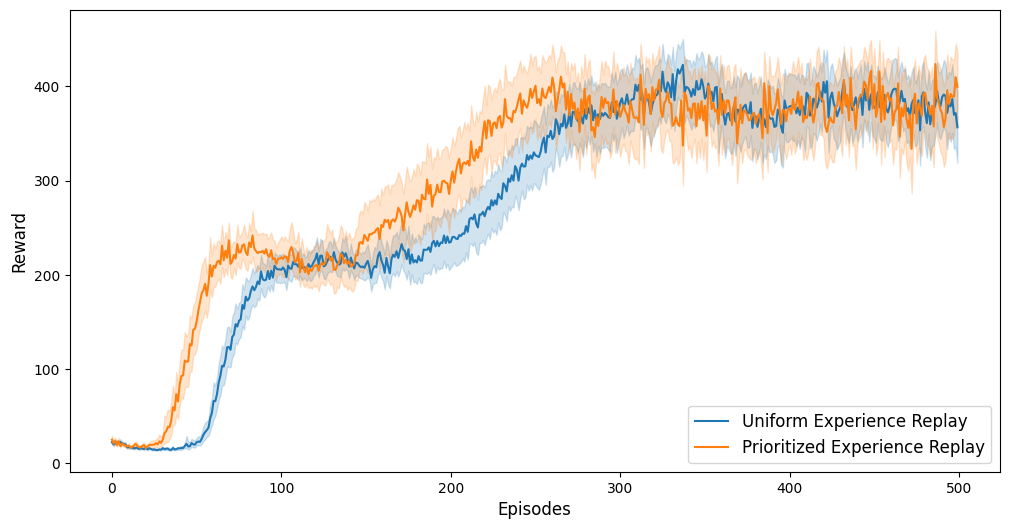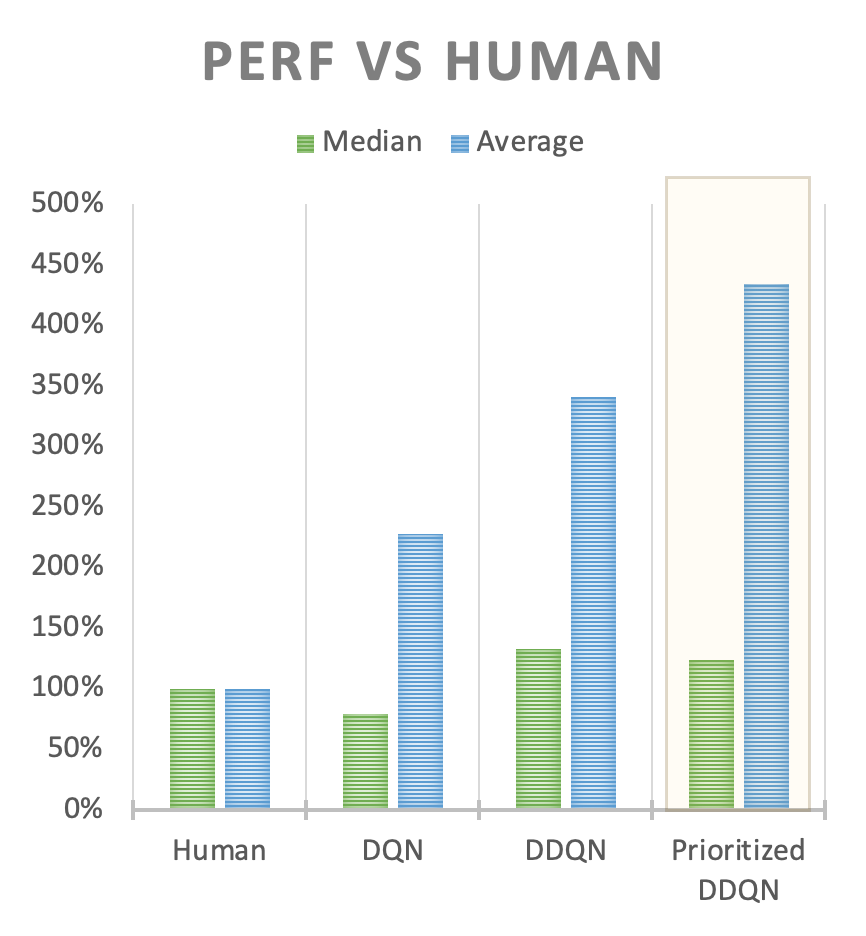Prioritized experience replay
Deep Reinforcement Learning in Python

Timothée Carayol
Principal Machine Learning Engineer, Komment
Not all experiences are created equal
- Experience Replay:
- Uniform sampling of experiences may overlook important memories
- Prioritized Experience Replay:
- Assign priority to each experience, based on TD errors
- Focus on experiences with high learning potential

Prioritized Experience Replay (PER)
for step = 1 to T do: # Take optimal action according to value function # Observe next state and reward # Append transition to replay buffer# Give it highest priority (1)# Sample a batch of past transitions# Based on priority (2)# Calculate TD errors for the batch# Calculate the loss and update the Q Network# Use importance sampling weights (4)# Update priority of sampled transitions (3)# Increase importance sampling over time. (5)
(1) New transitions are appended with highest priority $p_i = \max_k(p_k)$
(2) Sample transition $i$ with probability $$P(i) = p_i^{\alpha} / \sum_k p_k^{\alpha}\ \ \ \ \ \ \ \ (0<\alpha<1)$$
(3) Sampled transitions have their priority updated to their TD error: $p_i = |\delta_i| + \varepsilon$
(4) Use importance sampling weights $$w_i = \left( \frac{1}{N} \cdot \frac{1}{P(i)} \right)^\beta\ \ \ \ \ \ \ \ (0<\beta<1)$$
(5) Progressively increase $\beta$ towards 1
Implementing PER
def __init__(self, capacity, alpha=0.6, beta=0.4, beta_increment=0.001, epsilon=0.001): # Initialize memory buffer self.memory = deque(maxlen=capacity)# Store parameters and initialize priorities self.alpha, self.beta, self.beta_increment, self.epsilon = (alpha, beta, beta_increment, epsilon) self.priorities = deque(maxlen=capacity)...
Implementing PER
... def push(self, state, action, reward, next_state, done): # Append experience to memory buffer experience_tuple = (state, action, reward, next_state, done) self.memory.append(experience_tuple)# Set priority of new transition to maximum priority max_priority = max(self.priorities) if self.memory else 1.0 self.priorities.append(max_priority)...
Implementing PER
def sample(self, batch_size): priorities = np.array(self.priorities) # Calculate sampling probabilities probabilities = priorities**self.alpha / np.sum(priorities**self.alpha)# Randomly select sampled indices indices = np.random.choice(len(self.memory), batch_size, p=probabilities)# Calculate weights weights = (1 / (len(self.memory) * probabilities)) ** self.beta weights /= np.max(weights) states, actions, rewards, next_states, dones = zip(*[self.memory[idx] for idx in indices]) weights = [weights[idx] for idx in indices] states, actions, rewards, next_states, dones = (zip(*[self.memory[idx] for idx in indices]))# Return tensors states = torch.tensor(states, dtype=torch.float32) ... # Repeat for rewards, next_states, dones, weights actions = torch.tensor(actions, dtype=torch.long).unsqueeze(1) return (states, actions, rewards, next_states, dones, indices, weights)
Implementing PER
... def update_priorities(self, indices, td_errors: torch.Tensor): # Update priorities for sampled transitions for idx, td_error in zip(indices, td_errors.abs()): self.priorities[idx] = abs(td_error.item()) + self.epsilondef increase_beta(self): # Increment beta towards 1 self.beta = min(1.0, self.beta + self.beta_increment)
PER in the DQN training loop
In pre-loop code:
buffer = PrioritizedReplayBuffer(capacity)At the start of each episode:
buffer.increase_beta()
3. At every step:
# After selecting an action buffer.push(state, action, reward, next_state, done) ...# Before calculating the TD errors: replay_buffer.sample(batch_size) ...# After calculating the TD errors buffer.update_priorities(indices, td_errors)loss = torch.sum(weights * (td_errors ** 2))
PER In Action: Cartpole
100 training runs in the Cartpole environment:
- with Prioritized Experience Replay
- with Uniform Experience Replay
- Faster learning and better performance with PER than uniform experience replay

After 100 epochs:

After 400 epochs:

PER In Action: Atari environments
- Substantial performance boost with PER in Atari environments

1 https://arxiv.org/abs/2303.11634
Let's practice!
Deep Reinforcement Learning in Python

